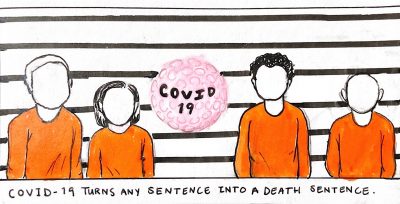COVID-19 is spreading rapidly throughout correctional facilities around the country. The Boston Globe reports that at the Massachusetts Alcohol and Substance Abuse Center in Plymouth, nearly a third of patients and close to a dozen workers tested positive for the virus.
Staying in a prison or correctional facility that has inadequate health care measures and near-impossible avenues for social distancing makes for a COVID-19 hotbed and what can effectively be a death sentence.

The New York Times reports that, as of Sunday, COVID-19 has infected more than 218,00 people in prisons and jails across the country.
Prisoners are already malnourished and living in foul conditions. There is much to say about the way inmates are treated, and the pandemic is exacerbating the prison system’s failing health care — they cannot escape the virus once it has infiltrated their facility.
Prisons must begin depopulating as an effort to ensure the utmost safety for inmates and staff. Without significant changes in health procedures throughout prisons and jails, the health of those inside the facilities will continue to be at risk.
The exit procedure must be safe for all involved, and should guide inmates to a positive transition back into the community.
While being relieved of your sentence early is not uncommon, it always poses a risk. Crime will never cease, and there is nothing stopping prisoners from reverting back to old habits. But if the screening process is thorough, we can assure a promising success rate.
The prison industry infamously targets certain groups while maintaining “law and order.” The War on Drugs has led to mass incarceration and exorbitant sentences for minor drug offenses. Drug-related offenders currently make up 46.2 percent of prison inmates in America, according to the Federal Bureau of Prisons.
We can assess the behavior of prisoners serving for non-violent crimes and release them accordingly. We must evaluate the likelihood that they would commit a crime after being released based on their character while serving.
If they were upholding and responsible, then we must have some faith that their punishment worked, and that they will not regress to old ways — people cannot be punished forever.
They must also be released in a way that protects their health. MASAC reported recently that an inmate who was released from civil confinement there tested positive after leaving. This is irresponsible and compromises public health in the community.
Prisoners must not only be tested prior to withdrawal, but should be provided personal protective equipment to prepare them for a pandemic-stricken outside world.
Beyond the need for physical health accommodations, resources for general life outside of prison or jail must also be a consideration. Prisoners should have access to a halfway house or some sort of facility that can offer them shelter if they do not have contact with family or friends.
It is incredibly difficult for anyone to secure a job right now, let alone someone who has been convicted of a crime. All of the barriers that come with previous imprisonment are just as deadly as COVID-19 — if you don’t have the resources to survive, you will end up right back where you came from, or worse.
But, this is an evergreen problem for the justice system, and we can begin addressing the issue by providing more mental health resources.
For those being released, mental health plays a large component in survival. Many prisoners do suffer from mental illnesses, which often contributed to their initial imprisonment.
Furthermore, those who were distributing or using hard drugs are susceptible to relapse once they are released. Resources must be provided to help these inmates transition into normalcy.
And for those still imprisoned, such as violent offenders, mental health resources are just as vital. The system is already detrimental to their health, but now, it’s as if everyone is in solitary confinement — this is not healthy nor natural.
In-person visits have resumed for prisons and jails, which is another risky but essential step. If we are allowed to go to football games and travel freely, then prisoners should be able to see their loved ones. Being imprisoned does not warrant total abandonment of social interaction.
Visitation can only take place in accordance with U.S. Centers for Disease Control and Prevention guidelines. If correctional facilities maintain proper social distancing measures, such as physical barriers in addition to PPE, then the spread could stay at bay.
Additionally, workers must also be careful not to be reckless with their actions, as they are the most likely avenues through which the virus can enter. Correctional systems must spare the resources to ensure prison and jail staff are consistently and properly tested for COVID-19.
The criminal justice system is facing nuanced challenges while caring for prisoners and staff members. The challenges are exacerbated by inadequacies that have always been present — we must now confront them head on.




















































































































